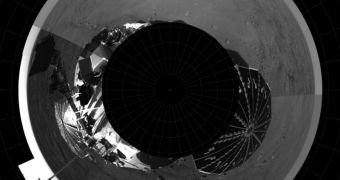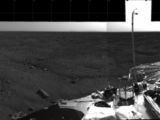After restoring communication with the Phoenix Mars Lander through the Mars Odyssey spacecraft, mission control resumed the preparation of the spacecraft for its scheduled digging mission, destined to establish whether or not Mars was ever hospitable for life. During its forth day on the surface of the Red Planet, Phoenix flexed the robotic arm for the first time and captured a panoramic image of the surrounding area.
"We have now achieved a major milestone for this mission", Phoenix project manager Barry Goldstein of NASA's Jet Propulsion Laboratory. The images sent back via the spacecraft in orbit around Mars show that the Phoenix Mars Lander succeeded in unpacking the arm and that it continues preparations for the beginning of its mission, sometime next week.
"I'm ecstatic to let you know that the robotic arm deployment was successful. It is raring to go. It's busted loose now and we're ready to go", said Matt Robinson, the robotic arm flight software lead from NASA's Jet Propulsion Laboratory.
Also, the panoramic image of the landing site was completed, revealing the solar panel arrays, the robotic arm and the meteorological mast on board the spacecraft.
"We have a very hummocky terrain", Phoenix principal investigator Peter Smith of the University of Arizona said. The area where Phoenix landed is located in the northern regions of the planet and appears to present polygonal-shaped patterns, similar to those on Earth, probably created by the repeated expansion and contraction of the ice under the 30 centimeter layer of dust covering the whole arctic landscape.
Meanwhile, the mission controllers hope to use the robotic arm to move some of the rocks in the vicinity of the spacecraft, in order to see what lies beneath them and study their origin. "The rocks don't come with labels, it's a little hard to tell where they came from", said Smith.
Meteorological measurements show that the temperatures in the area range between -30 and -80 degrees Celsius, therefore the robotic arm must be tested along the whole range of temperatures to ensure that it is functioning correctly. The camera attached to it will be used to observe the area under the spacecraft and confirm that no rocks are present there.
The terrain around Phoenix has been divided into two sections, one that will be used as digging site by the robotic arm and another one that will be left untouched until researchers are able to better understand the environment.
"It's more of a Superfund site over there, so we're allowed to mess that part up a bit", Smith said.

 14 DAY TRIAL //
14 DAY TRIAL // 
